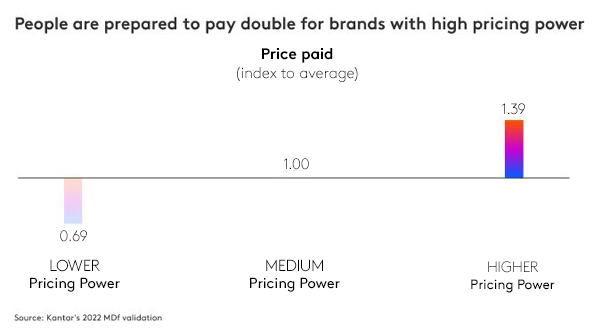When one economic crisis follows another and consumer confidence remains low, it would be easy for brands to feel resigned to their fate. Uncertainty is not a marketer’s friend, and there’s no certainty in the will-they-won’t-they threat of tariffs hanging over the United States. After years of managing high inflation and supply chain drama, brands now face looming trade wars; the notion that consumers might abandon their preferred brands for cheaper alternatives will be feeling increasingly real. In times like this, shifting focus from growth toward profitability becomes paramount. And while profits are the lifeblood of every company, it’s the CEO, finance and investors who are usually held to account. But marketers have more power than they might think. It’s in their gift to shape how sensitive their customers will be to price corrections, influence the amount charged on the shelf, and communicate these changes with impact.
Influencing consumer sensitivity through marketing
Good marketing goes beyond promoting products. It involves solving real problems for consumers. And rising prices could turn into a very real problem, very quickly. But successful pricing is about more than offsetting higher costs. “Most knives cut,” explained Jeremy Bullmore and Stephen King of J. Walter Thompson in the 1980s, “but people are happy to pay more for some and they are not deceived in any way.” More than 40 years on, the smartest marketers still strategize around pricing, striking for a differentiated brand positioning that can break through people’s expectation of parity.

When they do, consumers demonstrate a willingness to pay significantly more – up to double that of cheaper alternatives. This is what we call pricing power. Our data shows that with every additional point in pricing power, you can justify a four-point increase in relative price.

Concerned about tariffs? The link between pricing power and price elasticity is strongly established. The more you have of the former, the less willing people will be to switch to a substitute at a lower price – even at the premium end. Most importantly in today’s context, this remains true even amid economic uncertainties and rising costs.
So how do you land on the optimal price? It’s an art and science, requiring a perfect alignment between what’s being charged and consumers' perceptions.
A brand’s Meaningful Difference – how it meets emotional and functional needs and stands out from competitors – accounts for 94% of a brand’s pricing power. However, amid economic strain, brands must balance winning on demand, revenue, and margin, and consider the impact of pricing strategies on their market share.

With tariffs on the horizon, the temptation to increase prices is very real. But set them too high and you miss out on volume and revenue. Supply can end up greater than demand, leaving brands stuck in a cycle of higher unit costs or excess inventory. We’ve seen time and again how this causes shifts in consumer behavior, as people become ‘trained’ to buy only on promotion – a practice that takes years to course-correct.
Long-term pricing strategy requires an investment in brand equity, meaning brands need to act now to be prepared for the future. We studied brands over four years and found that those which improved their pricing power added 67% to their brand value compared with 33% for others. The pricing power effect is so strong that even when brands lose penetration over this period, a gain in pricing power more than offsets this – making it the best way to maintain profitability and sustain business value.
Softening the blow
Behavioral scientists have proven that pain centers in our brain activate in financial transactions, which explains why humans hurt on such occasions. That’s right – the threat of tariffs is physical, not just financial. It’s not enough to up prices and hope for the best. There’s groundwork to be laid. The savvy marketer will align their brand’s interests with those of the consumer and will never stop investing in the brand as a value-producing asset. And just like that, they remain the preferred choice. A financial crisis and great recession didn’t stop queues for the latest iPhone in 2008. Why? Because Apple signaled to their customers that they had no intention of removing value from their value proposition.
It’s not just how brands communicate this, but where. Our media effectiveness research reveals that although the average brands media budget prioritizes offline ad spend over online, it’s online that over-indexes when it comes to affecting difference.
In other words, digital advertising is the driving force behind brand difference, with YouTube, Facebook and TikTok ranked top of the powerful assets for unlocking brand difference and a brand’s pricing power.
But, a warning. Being blessed with pricing power doesn’t authorize the good marketer to launch a disorderly and unjustified price increase. You can focus on profits without profiteering. It’s not a contradiction. Brands can maintain their power in ways that are also affordable to consumers, who will always tilt towards brands that are meaningfully different – regardless of which countries their governments are happily trading with.
Where next?
The unpredictable nature of the US administration means nothing ever feels really off the table. Who knows how many countries will feel the blow of retaliatory tariffs, and what dent this will leave in the wallets of American consumers.
But marketers should take strength in the knowledge that action now will leave them empowered in the event of a trade war. Mastering the art of pricing is not just about profitability; it’s about resilience. No one asks for rising costs, but strong pricing power – and a strong brand – will leave brands better positioned when it happens.

